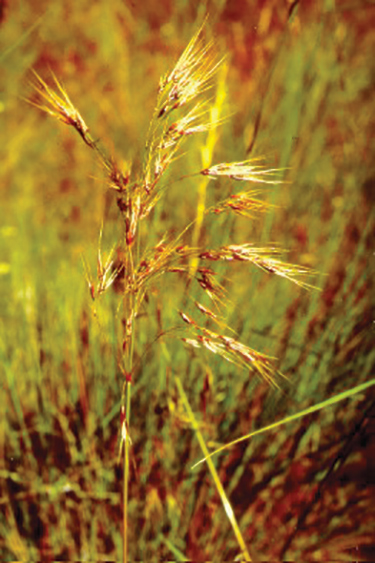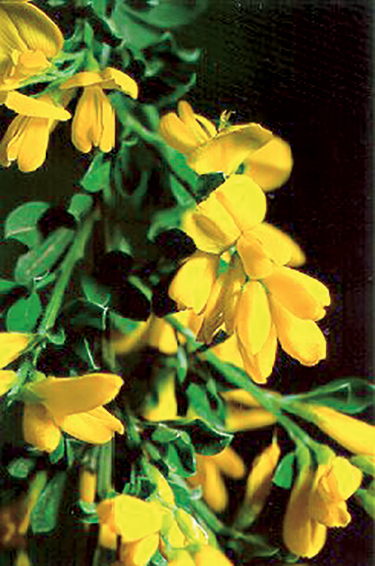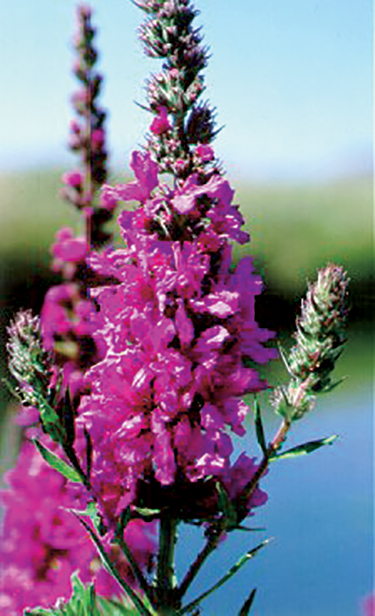In 2001, University of Washington Urban Horticulture Professor Sarah Reichard and her husband bought a house on Crown Hill, just a few minutes from where they lived on Phinney Ridge. The new house’s most attractive feature was its half acre of land, dominated by a lush ravine, where the previous owner clearly had spent some time and money on landscaping. “I sometimes think we are insane for getting this property but I wanted a big garden,” says Reichard. The problem was not what the previous owner had planted but the invasive plants that had taken over the ravine.
Clematis crept up massive bigleaf maple stumps like the gnarled green fingers of some subterranean beast. Himalayan blackberry, with its spiny branches that seem to double in length overnight, choked out native shrubs and herb Robert, a stinky, little lavender-flowered plant, sprouted in teeming masses that prevented native wildflowers from growing. When another botanist visited, he even discovered an invasive that no one had ever seen in North America. “We have spent and still spend every weekend pulling up invasives. It’s funny. I have been studying these plants for years but now it’s personal,” exclaims Reichard, an assistant professor of urban horticulture in the College of Forest Resources.
She is part of a growing movement of scientists who are studying how invasive plant species impact native systems. These scientists have discovered a disturbing fact — after habitat destruction, our invasive plants, animals and fungi cuse more harm to natives than pollution, disease or overharvesting. A 1999 study placed the annual economic cost of invasive plants in gardens, natural areas and agricultural lands in the United States at $35 billion.
Ecologists have not totaled up the annual cost of invasives in Washington state but the threat is pervasive. English ivy in city parks strangles and kills native alders, Douglas fir, and maples, in addition to providing ideal habitat for rats. Invasive Scotch broom and Russian knapweed (Centaurea repens) have helped push the golden paintbrush (Castilleja levisecta) and Washington polemonium (Polemonium pectinatum) on to the state’s threatened and endangered species list. Some invaders, such as St. John’s wort, are poisonous to livestock. Others reduce property values (Reichard believes she got her property at a good deal because of the invasives). In addition, herbicides and pesticides used against invasives end up in streams and threaten wildlife.

Cheatgrass – One of the 10 Worst Invaders in the Pacific Northwest. Photo courtesy the Nature Conservancy.
People have been collecting and transporting plants worldwide for thousands of years. European ornamentals appeared in the new world as early as 1631. Wealthy Englishmen sponsored explorers to scour the empire’s colonies in search of rare and unusual plants. Thomas Jefferson once wrote that “The greatest service which can be rendered any country is to add a useful plant to its culture.” One dubious plant that he helped introduce, at least in the east, was Scotch broom, which he grew at Monticello.
More recently and closer to home, Dan Hinkley, ’85, has been a leader in plant exploration and introduction. Nowhere is this better seen than at Heronswood, his nursery near Kingston. You feel transported back to the Permian Era, when all the continents were joined together. In one patch grow black-violet Chinese irises. In another, a Costa Rican giant with six-foot-wide leaves and yet another garden features plants from South Africa, Turkey and Korea. The shades of green alone would fill the largest box of Crayola crayons and the different shapes and colors of wildflowers feel like a kaleidoscope. You can clearly understand why people want exotic plants in their garden.
Unlike some in the horticulture trade, however, Hinkley makes his buyers aware of the risks of bringing in plants from other countries. His catalog contains a concise, thoughtful essay on being aware of the dangers of invasives. He also has Reichard review his plant list and red-flag those plants with a serious potential for invasion. Hinkley adds, “I love plants and it is a satisfying experience to offer a rich palette of plants to those who enjoy the process of gardening. It makes our lives more interesting and the world more understandable. I believe with thought plant introductions can be a safe and respectful process.”
Hinkley represents a new breed of horticulturalist. Nurseries, botanical gardens and individuals have historically driven the introduction of new species. One study found that 82 percent of the 235 woody plants identified as invasive originated in the horticulture trade. For example, legendary plant propagator Luther Burbank introduced the Himalayan blackberry from Europe — not Asia — in 1885. Capt. Walter Colquhoun Grant, who received seeds from the British consul in Hawaii, planted Scotch broom on his 30-acre farm on Vancouver Island in 1850. Not to be outdone, the United States Department of Agriculture can claim responsibility for bringing over kudzu and tamarisk, both of which rank high on a recent list of Washington state’s worst invaders.
“The best way to prevent a plant from becoming an invader is to prevent it from ever entering a country.”
Sarah Reichard, Urban Horticulture professor
Ironically, Reichard got her start in the very trade that has done more to bring invasive species into the country than any other. In 1988, while working on her master’s thesis, she traveled on a seed collecting trip to Chile for the Washington Arboretum. “When I got back, I started to wonder whether any of these seeds could become invasive. I was shocked that I found virtually nothing on how to predict if a plant had the potential to invade,” she says. Her thesis included one section on the invasive potential of her Chilean seeds. Since then she has expanded her work to create a litmus test for any introduced plant.
“The best way to prevent a plant from becoming an invader is to prevent it from ever entering a country,” she emphasizes. She found that the single best predictor of successful invasion was a previous invasion by that species somewhere else in the world. Other factors that indicated high potential included similar climate and latitude, high seed production, and long flowering and fruiting periods. The model she helped develop correctly classified 86 percent of past species that invaded but it does not answer the single biggest question: why do some plants become botanical cancer, reproducing uncontrollably and damaging their host environment.
Ecologists have offered several hypotheses to answer this question. One is analogous to a teenager going off to college and getting in trouble because the calming influence of her family is now gone. With plants, the theory is that invasives do well away from home because they no longer have predators or pathogens keeping them in check.
Another theory focuses on an invader’s ability to hybridize. Researchers recently discovered that the most invasive forms of tamarisk or salt cedar, considered to be the second worst offender in the country after purple loosestrife, were hybrids of two species that did not have overlapping ranges in their native environments. Plant expert Arthur Lee Jacobson believes that one such example in Seattle is the hybrid Japanese knotweed (Polygonum x bohemicum), a combination of Japanese knotweed (P. cuspidatum) and giant knotweed (P. sachalinense), that invades more successfully than either parent.

Scotch Broom – One of the 10 Worst Invaders in the Pacific Northwest. Photo courtesy the Nature Conservancy.
In the Pacific Northwest, invaders are aided by the mild climate. As we all know, plants thrive in the temperate, rain-soaked environment. They don’t have to adapt to freezing temperatures and rarely have to survive a drought. If an invader gets established during typical weather conditions, it may be able to survive the rare extremes. On a climatic plus side, many gardeners know that our dry summers can cause problems and do keep some plants, particularly woody deciduous ones, from getting a seed-hold.
“I don’t think there is a single answer to the question of why,” says Reichard. Around Puget Sound, she and other Center for Urban Horticulture staff and students are trying to address this question by focusing on some of the area’s infamous invaders, such as Scotch broom and herb Robert. Two factors stand out: high tolerance to stress and high reproductivity.
Scotch broom, for example, germinates best in dry sandy soils in full sunlight, such as roadways, where it often forms extensive stands. It can tolerate soils with a wide range of pH, sprouting on dunes, in heathlands and acidic grasslands. In addition, plants can fix nitrogen and endure drought, plus the seeds remain viable for up to 80 years. Although many people appreciate the brilliant yellow spring flowers, one writer considered it a poster child for the problems that invasives cause. “It is very aggressive, spreads rapidly, growing so dense that it is often impenetrable. It prevents reforestation, creates a high fire hazard, renders range land worthless and greatly increases the cost of maintenance of roads, ditches, canals, power and telephone lines,” says Reichard.
Herb Robert takes the high reproductivity approach. Unaffectionately known as Stinky Bob due to its musky aroma, it produces up to 3,100 seeds per square meter. Stinky Bob, which many people are allergic to, doesn’t just drop these seeds, it shoots them up to 20 feet away, where they can find new terrain or latch onto an animal and travel even farther. Unlike most natives, plants can also germinate in the fall. In full shade, this fecundity can result in as many as 250 plants per square meter, each multibranched and topped by 1/2-inch wide, five-petaled flowers.
No one knows exactly how or when herb Robert arrived in Washington state, in part because it has long been used in herbal medicine in its native habitat of Europe. Specimens probably arrived as garden ornamentals in several locations over many years and took decades to become a problem. Known as lag time, it is a typical behavior in invasives; a plant arrives, grows where it should for years to decades, and then explodes uncontrollably.
“What separates the bad from the very bad is the ability to invade undisturbed natural areas. I have seen pristine habitat where Stinky Bob literally took over in only a couple of years.”
Sarah Reichard, Urban Horticulture professor
Reichard hypothesizes several reasons for Stinky Bob’s sudden change from benign little garden plant to native-killing invasive. The plants may have evolved a new genetic makeup that facilitated its spread. It may be a matter of perception, or more likely, there were enough small patches in enough places that it reached a critical mass, where it could become cancerous.
Herb Robert ranks near the top of Reichard’s list of worst invaders. “What separates the bad from the very bad is the ability to invade undisturbed natural areas. I have seen pristine habitat where Stinky Bob literally took over in only a couple of years,” she says. Others include ivy, reed canary grass, Japanese knotweed, traveler’s joy, and purple loosestrife. One well-known invasive, Himalayan blackberry, is slightly less problematic because it only invades disturbed habitat. This does not mean that Reichard doesn’t spend hours pulling it out of her backyard, but blackberry probably will not invade a national park, as has herb Robert.
People have begun to fight back though. On a cool, foggy Saturday, Earth Day 2003, more than 200 volunteers gathered at Seward Park. Ecologists and historians consider the forest on the peninsula to be one of only two relic stands of old growth in Seattle. The dense woods support the largest tree in Seattle, a 23-foot-circumference Douglas fir, extensive stands of salal, and towering alders and bigleaf maples.
Despite these magnificent forests, Seward also suffers from invasives. Creeping buttercup and herb Robert spread in the shade. Purple loosestrife grows along the shorelines. Traveler’s joy (Clematis vitalba) climbs up the tallest trees. Ivy grows nearly everywhere, often battling Himalayan blackberry for supremacy.
The Earth Day crews had come to battle these invaders, particularly ivy. Clad in Gore-Tex and Carhartts, ratty jackets and torn jeans, young and old, black and white, they spread across Seward carrying rakes, pruning shears, and pulaskis. Their main method: tromp into a patch, grab the nearest plant, yank, wrap into a ball. Repeat. They emerged from the park at the end of the day dirty, scratched and sweaty. They had removed an estimated two acres of ivy.
The Earth Day event was organized by EarthCorps, a non-profit organization that employs 18 to 24-year-olds from around the world on habitat restoration in parks and green spaces in King County. They have also worked with volunteers at Frink Park and Madrona Woods, along the Duwamish River, in the Mountains-to-Sounds Greenway, and at Evans Creek/Cold Creek, near the Sammamish River. “I am always amazed to see how these volunteer events make an impact on people’s lives. It’s hard to make people understand the problems of invasives until they get out there and start to rip up plants,” says Liz Stenning, ‘94, a project coordinator at EarthCorps.
“People are the key to invasives because it is as much a social issue as a biological one,” adds Reichard. It is not a problem that can be solved simply by pulling out plants or through government regulation. “People need to realize that plants that grow in their own garden can spread easily. They need to ask nurseries to stop selling certain plants and ecologists need to better understand the mechanisms of invasion and to find alternatives for these popular plants. It is a long road but I am pleased with how far we have progressed.”
The 10 worst invaders in the Pacific Northwest

Purple Loosestrife – One of the 10 Worst Invaders in the Pacific Northwest. Photo courtesy the Nature Conservancy.
Cheatgrass { Bromus tectorum }
Arrived in country in late 1800s in contaminated wheat. Thrived because it could grow on disturbed habitat, preadapted to wet, cold winters and dry, hot summers, and because it outcompeted natives after fire.
English ivy { Hedera helix }
Spreads aggressively by seed and vegetatively. Introduced for erosion control as early as the 1860s. Planted in Seattle city parks in 1890s.
European beach grass { Ammophila arenaria }
Introduced in the late 1800s to stabilize dunes around San Francisco. It thrives on burial, which is necessary for vigorous growth and flowering, and becomes dominant by heavy foliage cover.
Iberian/Purple/Yellow Starthistle { Centaurea iberica, C. calcitrapa, C. solsitialis }
Copious production (150,000 seeds/plant) of wind blown seeds that spread by vehicles, animals (particularly finches), and contaminated seed. Arrived as a contaminant, probably, as early as 1920s in eastern Washington.
Japanese knotweed { Polygonum cuspidatum }
Introduced to the U.S. for use in ornamental hedges and for erosion control. Plants emerge early in spring, which helps them get established and dominate a site. A deep, thick mat of rhizomes prevents easy root removal.
Leafy Spurge { Euphorbia esula }
High germination rate, explosive seeds, and vegetative reproduction. Unknown arrival date, but probably in contaminated seed or ship ballast.
Purple loosestrife { Lythrum salicaria }
Spreads both vegetatively and by seed to form dense, monotypic stands of little or no habitat benefit. First found on the shores of Lake Washington in 1929. Popular horticulturally and medicinally.
Reed canary grass { Phalaris arundinacea }
Aggressively spreads by rhizomes, out-competing and eliminating natives. May be a native that has crossed with non-natives to produce more vigorous growth.
Scotch broom { Cytisus scoparius }
Tolerant to a wide variety of soil types with long lived seeds and the ability to fix nitrogen. Seeds were given as gift from English consul in Hawaii to a Captain Grant in 1850 on Vancouver Island.
Tamarisk { Tamarix ramosissma }
A single plant can produce a half million seeds per year. Stems and leaves secrete salt, which inhibits growth of other plants. Introduced for erosion control and as ornamental in California in 1861.